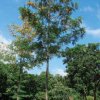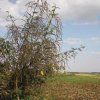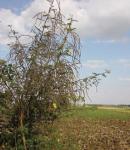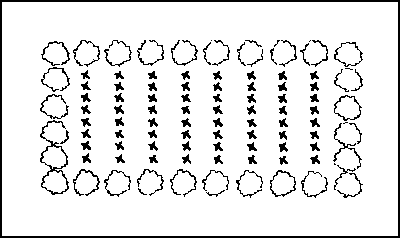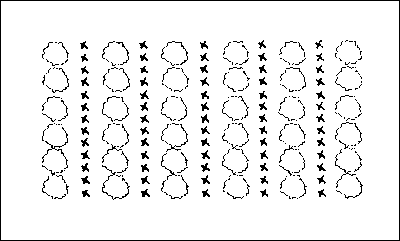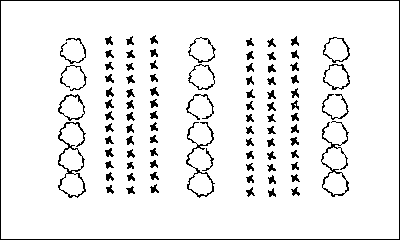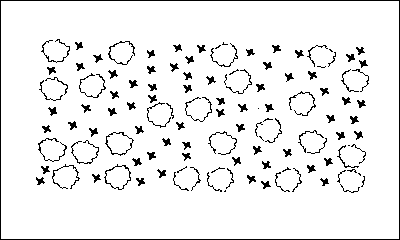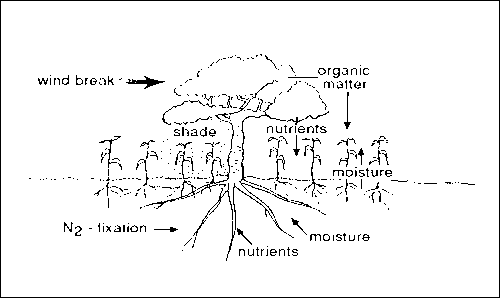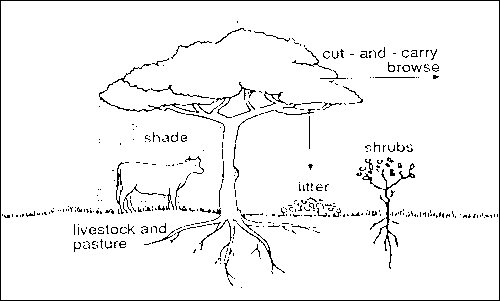Guide to tree planting in Kenya (under review)
Description: This guide was designed by scientists from Kenya Forestry Research Institute (KEFRI) to provide useful working information to field workers and farmers involved in tree planting in Kenya. It includes information on the requirements of various tree species in different agro-ecological zones regarding soil, climate, uses and expected rotation.
Introduction
Chosing tree species for planting
The choice depends on:
- The purpose of planting: Species selected must be able to fulfill the objective for planting them - e.g. soil and water conservation - in catchment areas, improvement of soil fertility (supply of mulching material, green manure), animal fodder, shade, and saleable products such as fruits, fire wood and charcoal, timber for construction, craft materials, etc.
- The environment e.g. climatic conditions, soil type and altitude
- The ability of the species to establish and provide a wide range of utility, preferable for more than one purpose and a high degree of profitability
The remaining five ecozones are deemed as receiving annual rainfall as follows:
- Ecozone II (over 1400 mm)
- Ecozone III (800 to 1400 mm)
- Ecozone IV (400 to 800 mm) and
- Ecozone V and VI (less than 400 mm)
Trees used in Agroforestry
| Species | Ecology | Management System | Tree management | End Use | Remarks | |
|
Grevillea robusta
© P. Maundu, World Agroforestry Centre, Nairobi, Kenya |
The Grevillea robusta originated from Australian and is widely used in Africa, 0 - 3000 m. It does well on neutral to acidic loam or light sandy soils but is not tolerant to waterlogging or heavy clays. Found in Ecozones II - V |
The Grevillea .spp may be found in; Plantation, Hedge planting, Agroforestry (coexisting with food-crops), Woodlot and, Shelterbelt system |
The Grevillea .spp may be propagated by use of wildings or seedlings. Pollarding, lopping, coppicing and pruning optimizes their benefits if used in their management. Note; Only young trees coppice well Maturity takes 6 yrs for poles and 30 yrs for timber |
Firewood, charcoal, timber, furniture, poles, veneer, fodder (leaves low quality), bee forage,shade, ornamental, mulch, soil conservation and, windbreak | Some communities believe the species attracts lightning in homesteads. However, it is an extremely important tree in the Kenyan highlands and has become an integral part of the farming system in many areas. | |
|
Sesbania sesban
|
The Sesbania spp survive waterlogging and fix nitrogen improving the soil fertility. Naturally, it distributed from Senegal to Somalia and south to South Africa. It's all over tropical Africa and Asia. It tolerates acid and saline soil and is common in riverine vegetation and in Kenya, is found at the margin of fresh water lakes like Naivasha and Baringo and in seasonal swamps. Widely cultivated in western Kenya; 350- 1,900 m above sea level and Ecozones I - IV | May occur in dense stands, agroforestry (mixed farming system), conservation | The tree is very fast growing and pruning and short rotation is employed in their management. Propagation is by direct sowing at site or wilding and it takes 2 to 3 years to reach maturity. | Firewood, poles, medicine (leaves and roots), fodder, shade,soil enrichment via nitrogen fixation,soil conservation (improved fallows), fibre, veterinary medicine and, soap (leaves) | The species harbours rootknot nematodes and should therefore be avoided in combination with crops that are very sensitive to nematodes like banana & irish potatoes. Widely used in western Kenya, this tree has a great potential for soil improvement on small farms due to nitrogen fixation and leaf mulch. | |
| Croton megalocarpus (Mukinduri) |
Found in Tanzania, Rwanda, Burundi, Uganda, Kenya, Congo (DRC), Malawi, Zambia and Mozambique. In Kenya is wide spread, from the south to the western and northern parts of the country. Found in Ecozones III-IV but very common in zone III, 1000 - 2000 m above sea level and is well adapted to variable highland soils | It may occur in mixed farming systems, woodlots, boundaries and, agroforestry systems | It may be propagated by direct sowing at site (recommended), seedlings (sow seed directly in pots) or wilding. It's fast growing in high potential areas, slow elsewhere; lopping, pollarding and coppicing may be employed.It takes 10 to 25 years to mature. |
Firewood (smoke may irritate eyes), timber, charcoal, poles, medicine (bark), bee forage, shade, ornamental, mulch, live fence, boundary planting (popular among Kikuyu) and, veterinary medicine | Seed has high oil (30%) and protein content(50%). Oil extract can be a strong purgative. It is not recommended for intercropping due to competition and shade. Cultural beliefs prevent it from being planted close to homes | |
| Cordia abyssinica / Cordia africana (Muringa) |
A large deciduous forest tree of moist warm areas, woodland and bush. Widespread in Kenya, common in pasture land between 1,200 and 2,000 m. mainly in Central Province, around Nairobi, in Meru, Marsabit, Kakamega, and Kisii Districts and in parts of Rift Valley Province. Tends to be riverine in drier areas. Ecozones II - III. | Plantation, mixed woodlots, amenity, agroforestry | Propagation; wildings and seedlings. Moderate to slow growing; taking 30 - 60 yrs to mature. Pollarding, lopping and coppicing may be applied. Several seedlings may germinate from each stone. Can be pricked out. Young trees grow best under some shade. Tend to branch a lot if grown in full light. | Timber, firewood, furniture, beehives, utensils (mortars), edible fruit, medicine (bark, roots), fodder (dry season), bee forage, shade, ornamental, mulch, soil conservation, fibre, glue, boundary marking. | The heartwood is hard and takes a good polish, so the timber is prized for furniture, but it can be twisted and difficult to saw. Often found in cropland where it is managed to reduce shade. Provides very good mulch. | |
| Markhamia lutea (Zusiala) |
A tropical African tree common in the lake basin and highland areas, to 2,000 m. It stands acid heavy clay soil, but not waterlogging; prefers red loam and has deep roots. Ecozones II-III | Plantation/ amenity/ agroforestry systems | Propagated by use of seedlings and wildings. Are fast growing and coppicing may be employed in their management. They take between 15 - 30 yrs to mature | Firewood (domestic as well as tobacco curing), charcoal, timber, furniture, poles, posts, tool handles, walking sticks, boat building, banana props, medicine (leaves), bee forage, shade, ornamental, mulch, soil conservation, windbreak, ceremonial, boundary marking. | The species is widely used in western Kenya. The wood is fairly termite resistant. | |
| Markhamia lutea (Siala) |
1400 III Red loam to clay loamy soil |
Plantation/ woodlot/ amenity agroforestry systems |
Timber/ amenity/ soil nutrient input |
Short (15 - 30 yrs) | ||
| Calliandra calothyrsus | 0 - 1400 III Variable |
Agroforestry system | Fuel, soil nutrient enhancing |
Short | ||
| Casuarina equisetifolia (Whispering pine) |
Occurs naturally on tropical sea shores - Pacific and Indian Oceans, making it theCasurina with the widest natural distribution.In Kenya is common along the coral beaches and nearby hinterland, 0-1,400 m. The extensive root system enables it to grow in poor soils. It tolerates salty winds and poor, salty and sandy soils of the beaches. Ecozones I-IV but limited to the coast. Seeds at the coast mainly in July - August and February - March | Plantation/ agroforestry | Seedlings and wildings may be used. Produces root suckers if roots are exposed. Nursery soil where they are to be raised may need inoculation by addition of soil from beneath mature trees. Are fast growing and prune to get clear bole. Coppices when young, but less vigorously than C.cunninghamiana.. Takes 4 - 6 yrs to mature) |
Firewood (burns very well), charcoal, furniture, poles (for house construction), posts, boat building (dhow masts), tool handles, fodder, shade, ornamental,mulch, nitrogen-fixing, soil conservation, reclamation of degraded areas, sand-dune stabilization, windbreak, tannin, dye | The species is said to exhaust soil moisture and lower the water table, and is tolerant to salt water. It suppresses undergrowth and dry needles on the ground may become a fire hazard. The species is reputed to be one of the best fuel species in the world. | |
| Gliricidia sepium (Mother of cocoa) |
A tree or shrub, wide spread in the tropics due to its many uses and speed of growth. Grows in a variety of soils, both acidic and those low in fertility, mainly in humid lowlands, 0-1,600 m. In Kenya it also does well in drier areas like Kitui and Isiolo. Ecozones III-VI. | Woodlots/ agroforestry systems |
Propagation is by seedlings, cuttings, direct sowing at site(cuttings are best option for live fence). Are fast growing; coppicing, pollarding & lopping may be employed | Firewood, poles, fodder (leaves, pods, seeds for ruminants and shoots), bee forage, shade,mulch,ornamental, nitrogen fixing, soil conservation, windbreak, live fence, stakes. | The Latin name means "rat-killer" as a poison can be made from the leaves which is toxic to rats as well as other non-ruminants like pigs, donkeys and horses. Bark, roots and seeds may also contain poison. A very useful quick fence can be grown from crossed stakes which soon sprout. Wood is resistant to termites | |
| Leucaena leucocephala (Lusina) |
Widely introduced in the tropics, grows well at altitudes of 0-1,600 m, in full sunlight and in well drained neutral or calcareous soil.Does not tolerate acidic soils. Needs more than 600 mm rainfall. It is naturalized and to some extent invasive in some parts of Kenya with moist ground and warm climate. A psyllid insect pest, Heteropsylla cubana, causes defoliation. In Kenya, the psyllid defoliates the leucaena, resulting in severely reduced production of fodder as well as wood, but without killing the leucaena. Ecozone II-V | Woodlots/ mixed agroforestry systems |
Propagation is via Seedlings and direct sowing at site. Is very fast growing on suitable sites; pollarding, lopping and coppicing may be employed. It can become a weed. | Firewood, poles, medicine (roots), fodder (leaves and shoots), bee forage, shade, mulch, nitrogen fixing, soil conservation and improvement, windbreak, tannin, dye | The species exhibits great variation. The mimosine in the leaves can cause hair loss, infertility and stomach problems in livestock, especially non-ruminants like donkeys. Livestock feed should not contain more than 20% Leucaena | |
| Acacia tortilis | Common in most of dry Africa from North and West Africa to South Africa. Wide spread in lowland arid and semiarid areas of kenya. Tolerates a wide range of soils, from sandy, silty to black-cotton soils. May be dominant on dry red soils and prefers slightly alkaline conditions. Often stands along rivers, 0-1,650 m. Can grow in shallow soils is among the most drought-resistant of the acacias in Kenya. Rainfall 150-900 mm. Ecozones IV-VII | Mixed enrichment/ agroforestry | Propagation is by seedlings, wildings, direct sowing at site (seeds taken straight from pod rarely germinate due to seed dormancy), It's slow growing but may grow relatively fast on dry sandy soils if weeding is done and goats are kept away. Also withstands moderate lopping and does not coppice well. Prune when young. | Firewood, timber, charcoal, poles, edible pods medicine, fodder (pods and leaves, especially for goats and camels), bee forage, shade (meeting place for Turkana), ornamental, dune fixation, nitrogen fixation, soil conservation, fibre (strings made from bark), live fence, tannin, dye, thorn used as pins or needles, veterinary medicine. | The tree is limited to desert areas. Its pods are popular feed for livestock - are even collected and saved for dry season and even sold in northern Kenya. Should not be planted near homes due to its thorns and the likelihood of attracting caterpillars that feed on it. | |
| Prosopis chilensis (Algaroba) |
Cultivated all over the tropics, it's drought resistant and grows on light sandy soils.Tolerant to extreme temperatures, severe drought, overgrazing and waterlogging but is sensitive to weed competition while young. Introduced in Kenya, e.g. in Baringo, Wajir, Magadi, Mandera and Turkana, 0 - 1,500 m. Prosopis .spp, generally referred to as mesquites, have demonstrated their invasiveness in Kenya especially in irrigation schemes in hot areas. Ecozones IV-VII. Does well in sandy to sandy-clay soils to riverine clay/ sandy soils | Enrichment/ agroforestry systems |
It's propagated by seedlings or direct sowing at site. Fairly fast growing even in dry conditions; coppicing, pruning. Leaves and pods can be lopped for goats. | Fodder (pods), firewood, charcoal,soil protection, poles, posts, edible fruit and leaves, bee forage, shade, gum, tannin and live fence | Since the tree has become a weed in wetter areas, planting in cultivated areas should be avoided. There are about 44 mesquites, most of which are found in the warmer parts of the Americas and a few in Asia and Africa.A number of them are terrible weeds. | |
| Melia volkensii (Mkau) |
A valuable tree in the ASALs of Ethiopia and Somalia south to Tanzania. In Kenya is found in Kitui, Mwingi, Machakos, Embu, Taita, Samburu, Isiolo, Makueni, Voi, Tsavo National Park and Moyale in dry bushland or woodland and drier wooded grasslands. Altitude ranges from 400 to 1,650 m and in Ecozones V-VI. Does well in sandy to sandy-clay soils to riverine clay/ sandy soils | Mixed/ agroforestry systems | It may be propagated by seedlings, root cuttings or root suckers, wildings. The tree grows faster if propagated using root suckers. Young trees needs to be protected from goats and coppicing can also be done | Firewood, timber (construction, door frames), medicine (bark), fodder (fruit), bee forage, shade,mulch, soil conservation. | Wood hard, brown, and makes good timber, resistant to attack by borers.It is a highly prized tree in the dry areas where it is intercropped with food crops with no adverse effects and occasionally improved yields. | |
| Tamarindus indica (Mkwaju) |
It is indigenous to tropical Africa; widely used in the Sahel, India, South East Asia, the Caribbean and Central America. A very adaptable species, drought hardy, preferring semi arid areas and wooded grasslands, tolerating salty, coastal winds, even monsoon climates, Altitude ranges from 0 to 1,500 m. Grows in most soils, but prefers well-drained deep alluvial soil; often riverine in very dry areas. Found in Ecozones III-V | Mixed/ agroforestry systems amenity |
Good mother trees are chosen for vegetative propagation. Seedlings, wildings, direct sowing at site, grafting and budding for best varieties. They are slow growing but long lived; pollarding, coppicing and, pruning may be used. | Firewood, charcoal, timber, furniture, poles, posts, utensils (pestles and mortars, carts), boat building, food (edible fruit pulp, pulp also used for souring porridge, drink, fried seeds, seasoning, flavouring), medicine (leaves, twigs, bark, roots), fodder, bee forage, shade, ornamental, mulch, nitrogen fixing, tannin, dye, veterinary medicine | The fruit has many uses and is important for nutrition in many parts of the world, not least in India. | |
| Prosopis chilensis (Algaroba) |
Cultivated all over the tropics, it's drought resistant and grows on light sandy soils.Tolerant to extreme temperatures, severe drought, overgrazing and waterlogging but is sensitive to weed competition while young. Introduced in Kenya, e.g. in Baringo, Wajir, Magadi, Mandera and Turkana, 0 - 1,500 m. Prosopis .spp, generally referred to as mesquites, have demonstrated their invasiveness in Kenya especially in irrigation schemes in hot areas. Ecozones IV-VII. Does well in sandy to sandy-clay soils to riverine clay/ sandy soils | Enrichment/ agroforestry systems |
It's propagated by seedlings or direct sowing at site. Fairly fast growing even in dry conditions; coppicing, pruning. Leaves and pods can be lopped for goats. | Fodder (pods), firewood, charcoal,soil protection, poles, posts, edible fruit and leaves, bee forage, shade, gum, tannin and live fence | Since the tree has become a weed in wetter areas, planting in cultivated areas should be avoided. There are about 44 mesquites, most of which are found in the warmer parts of the Americas and a few in Asia and Africa.A number of them are terrible weeds. |
Trees suitable for Eco-Zone II (over 1400 mm rainfall)
| Species | Altitude (m) | Soil Type | Management System | End Use | Rotation |
| Acacia mearnsii (Black wattle) |
1600 - 2000 | Deep to medium red to red loamy |
Plantation/ woodlot | Tanning, fuel | Short - (6 - 10 yrs) |
| Acacia melanoxylon | 2000 - 3000 | Variable deep red to loamy sandy soils |
Plantation/ mixed planting |
Soil conservation, timber, fuel |
Short (8 yrs) (30 yrs timber) |
| Arundinaria alpina (Bamboo) |
2200 - 3000 | Deep red to volcanic loamy soils |
Plantation, boundary, groves, soil protection |
Building, fencing, handicraft, soil protection |
Short (6 - 10 yrs) |
| Bischofia javonica (Bischof wood) |
1200 - 1600 | Deep red/ loamy soils |
Plantation, enrichment planting |
Timber | Short (30 - 40 yrs) |
| Chlorophora excelsa (Mvule) |
0 - 1400 | Variable sandy to deep soils |
Plantation/ mixed planting |
Timber | Medium to long |
| Cordia abyssinica (Muringa) |
1400 - 2500 | Variable and wide spectrum but deep |
Plantation | Timber/ shade | Medium to long (30 - 60 yrs) |
| Croton megalocarpus (Mukinduri) |
1000 - 2000 | Variable deep red to loamy sandy soils |
Plantation/ mixed/ enrichment/ natural systems |
Fuel, poles, construction, peeler wood |
Short to medium |
| Cupressus lusitanica | 1800 - 3000 | Highland (variable) soils | Plantation | Timber/ hedge shelterbelt |
Short (25 - 30 yrs) |
| Eucalyptus regnans (Mountain ash) |
2500 - 3000 | Deep highland forest soils |
Plantation/ woodlots | Fuel, poles, building timber |
Short (4 - 6 yrs - poles) (10 -20 yrs for timber) |
| Eucalyptus saligna/ grandis (Blue gum) |
1400 - 2500 | Variable, medium to deep soils |
Plantation/ woodlots | Fuel, transmission posts construction, potential timber, pulp |
Short (15 - 25 yrs - for timber) (5 - 12 yrs for other uses) |
| Fagara microphylla | 1200 - 1900 | Deep red to sandy loamy soils |
Plantation, enrichment planting system |
Timber | Short to medium (40 -80 yrs) |
| Maesopsis eminii (Mutere) |
1200 - 1600 | Deep red/ loamy soils |
Plantation/ mixed enrichment systems |
Timber | Short (25 - 50 yrs) |
| Ocotea usambarensis (Camphor) |
1600 - 2500 | Volcanic deep loamy soils |
Plantation/ mixed systems |
Timber | Medium to long |
| Olea welwitchii (Elgon Teak) |
1600 - 2400 | Deep loamy soils | Plantation/ mixed natural systems |
Timber | Long |
| Phoneix reclinata | 0 - 3000 | Swampy and riparian soils | Mixed systems amenity | Water conservation, basketry, ornamental |
Medium to long |
| Pinus patula | 1600 - 300 | Deep wet loams | Plantation | Timber/ paper | Short (16 - 20 yrs - pulp) (25 - 30 yrs for timber) |
| Polyscius kikuyuensis (Mutati) |
1600 - 2500 | Variable, red to loamy clay soil |
Mixed, enrichment and natural management systems |
Peeler wood for boards mainly |
Short (30 - 40 yrs) |
| Prunus africanum (Muiri) |
1600 - 2500 | Variable | Plantation/ mixed and natural |
Timber | Medium to long |
| Syzygium species | 1000 - 2500 | Swampy and riparian soils |
Mixed systems in water courses |
Water conservation timber |
Medium to long |
| Vitex Keniensis (Meru oak) |
1700 - 2200 | Deep volcanic, red to loamy clay soil |
Plantation/ natural management system |
Timber | 40 - 50 yrs |
Trees suitable for Eco-Zone III - Highland region (800 -1400 mm rainfall)
| Species | Altitude (m) | Soil Type | Management System | End Use | Rotation |
| Aberia caffra (Kei apple) |
1400 - 2200 | Variable soils | Hedge Management | Hedge | Short to long |
| Acacia xanthophloea | 1000 - 2000 | Riparian soils | Mixed system | Water conservation, soil conservation , soil enrichment |
Medium |
| Brachylaena huillensis (Muhugu) |
200 - 1850 | Mainly red loamy and sandy soils |
Woodlot, mixed enrichment system |
Timber, fencing, carving |
Medium to long (60 - 100 yrs) |
| Cupressus lusitanica | 1800 - 2500 | Well adaptable to variable highland soils |
Plantation | Timber/ hedge/ shelterbelt |
Short (25 -30 yrs) |
| Eucalyptus saligna/ grandis (Blue gum) |
1400 - 2500 | Highland loamy soils | Plantation/ woodlots/ shelterbelts |
Fuel, poles, posts, fencing |
Short (5 - 12 yrs - for poles) (15 -25 yrs - timber) |
| Jacaranda | 1600 -2500 | Variable soils | Single tree management | Amenity | Short |
| Juniperus procera (Cedar) |
1500 - 300 | Red loam to rocky shallow drained soils |
Plantation/ woodlots/ mixed |
Timber, posts, fencing, protection |
Medium to long ( 60 - 100 yrs) |
| Macheria tippu (Tipuana tipu) |
1600 - 2000 | Red loams to black cotton soils |
Plantation/ mixed | Timber | Short to medium (20 - 40 yrs) |
| Olea africana (Mutamaiyu) |
1600 - 2200 | Red clay loamy soils | Mixed planting | Beams, posts, carvings, fencing, wood fuel |
Long (80 - 120 yrs) |
| Podocarpus gracillor (Podo) |
1800 - 2400 | Red to loamy clay and volcanic soils |
Plantation/ mixed/ amenity |
Timber, amenity | Medium to long (50 - 80 yrs) |
| Pinus Patula | 1600 - 3000 | Adaptable to variable soils but poor in clay and water-logged soils |
Plantation | Timber and paper manufacture |
Short (16 - 20 yrs - pulp) ( 25 - 30 yrs - timber) |
| Phoenix reclinata | 0 - 3000 | Swampy and riparian soils | Mixed system, amenity | Water conservation, basketry, ornamental |
Medium to long |
| Prunus africanum (Muiri) |
1600 - 2500 | Highland red loamy to volcanic deep soils |
Plantation/ mixed/ enrichment planting systems |
Timber | Medium to long |
| Schinus molle (Pepper tree) |
1500 - 3000 | Variable red to cotton loamy soils |
Boundary/ ornamental planting |
Amenity, fuel | Short (10 - 20 yrs) |
| Spathodea nilotica (Nandi flame) |
1200 - 2200 | Variable Soils | Amenity system | Amenity | - |
| Syzygium species | 1000 - 2500 | Swampy and riparian soils |
Mixed system in water courses |
Water conservation, timber | Medium to long |
Trees suitable for Eco-Zone III - Lowlands (800 - 1400 mm rainfall)
| Species | Altitude (m) | Soil Type | Management System | End Use | Rotation |
| Azadirachta indica (Mwarobaini) |
0 - 1400 | Sandy to sandy-loam | Plantation /mixed | Timber, fuel, fencing, amenity, medical |
Short |
| Borassus aethiopum (Borassus palm) |
0 - 1400 | Variable but mainly riparian | Mixed systems | Water conservation, palm wine, basketry |
Medium to long |
| Brancylaena huillensis (Muhugu) |
200 - 1850 | Red loamy to clay loam sandy soils | Mixture/ enrichment natural system |
Timber, fuel, carvings, construction, fencing |
Medium to long |
| Brachystegia spiciformis (Mrithi) |
0 - 200 | Red loamy to clay loam sandy soils | Mixture/ enrichment/ natural system |
Timber, railway sleepers | Medium to long ( 60 - 100 yrs) |
| Cassia siamea | 0 - 1400 | Sandy to sandy-loam | Plantation/ mixed | Timber, fuel, fencing | Short |
| Chlorophora excelsa (Mvule) |
0 - 1400 | Red clay-loamy to sandy loamy soils | Plantation/ mixed systems |
Timber | Short to long |
| Dalbergia melanoxylon (Mpingo) |
0 - 1400 | Variable, sandy to sandy - clay | Plantation/ mixed | Timber, fuel fencing, wood carving, |
Long |
| E. camaldulensis | 0 - 1400 | Red clay-loamy to sandy-loamy soils |
Plantation/ shelter-belt woodlot systems |
Fuel, poles, construction |
Short (6-8 yrs) |
| E. europhylla | 0 - 1400 | Sandy to clay loams | Plantation/ woodlots | Fuel, poles, posts | Short (5 - 12 yrs) |
| Ficus sycomorus | 0 - 2000 | Riparian soils | Mixed systems | Water conservation fodder |
medium to long |
| Gmelina arborea | 0 - 1400 | Sandy to sandy loam soils | Plantation | Timber, paper, match box light construction |
Short (15 - 25 yrs) |
| T. brownii (Koloswo) |
0 - 1400 | Sandy to sandy/ clay loams |
Woodlots, mixed plantings |
Fuel, fodder, posts | Short |
Trees suitable for Eco-Zone IV (400-800 mm rainfall)
| Species | Altitude (m) | Soil Type | Management System | End Use | Rotation |
| Acacia albida | 1000 - 14000 | Sandy to sandy-clay soils to riverine clay/sandy soils |
Mixed, woodlot, riverine plantings | Fuel, poles | Short |
| A. senegal (Gum arabicum) |
1000 - 1400 | Sandy to sandy-clay soils to riverine clay/ sandy soils |
Woodlot/ mixed enrichment |
Fuel, poles, gum arabic production |
Short (15 - 25 yrs) |
| Acacia plycantha | 1000 - 14000 | Sandy to sandy-clay soils to riverine clay/ sandy soils |
Mixed/ woodlot systems | Fuel, poles | Short |
| Acacia seyal | 1000 - 14000 | Sandy clay to sandy loam soils |
Woodlot, mixed enrichment planting systems |
Fuel, poles posts | Short |
| Azadirachta indica (Mwarobaini) |
0 - 14000 | Sandy to sandy-clay soils to riverine clay/ sandy soils |
Mixed/ enrichment planting system | Timber, fuel, poles, fodder | Short |
| Balanites aegyptiaca | 500 - 1400 | Sandy to sandy-clay soils to riverine clay/ sandy soils |
Mixed/ enrichment planting system |
Timber, fuel | Short |
| C. megalocarpus (Mukinduri) |
1000 - 2000 | Sandy to sandy-clay soils to riverine clay/ sandy soils |
Woodlot/ mixed enrichment systems |
Fuel, agropoles | Short to medium (15 - 25 yrs) |
| Dalbergia melanoxylon | 0 - 1400 | Sandy to sandy-clay soils to riverine clay/ sandy soils |
Woodlot/ mixed/ enrichment systems |
Timber, fuel, poles, carvings | Medium to long |
| E. camaldulensis | 0 - 1400 | Sandy to sandy-clay soils to riverine clay/ sandy soils |
Plantation/ woodlot/ boundary plantings |
Fuel, poles, posts | Short (6 - 8 yrs) |
| Ficus sycomorus | 0 - 2000 | Riparian soils | Mixed systems | Water conservation | Medium to long |
Trees suitable for Eco-Zone V-VI (under 400 mm rainfall)
| Species | Altitude (m) | Soil Type | Management System | End Use | Rotation |
| A. Senegal (Gum arabicum) |
1000 - 1400 | Sandy clay to sandy loam soils |
Woodlot/ mixed enrichment planting |
Fuel, poles, gum arabicum |
Short |
| Cordia sinensis | 1000 - 1500 | Sandy clay to sandy loam soils |
Woodlot/ enrichment systems |
Fuel, poles, fodder | Short and medium |
| Hyhaena ciriacea (Doum palm) |
0 - 1000 | Sandy riparian soils | Mixed systems | Water conservation, basketry |
Medium to long |
| Salvadora persica | 1000 - 1500 | Sandy clay to sandy loam soils |
Woodlot/ enrichment systems |
Fodder, soil protection, amenity |
Short to medium |
| Syzyphus mauritiana | 1000 - 1500 | Sandy clay to sandy loam soils |
Hedge planting management |
Life fencing, fruits | Short to medium |
Information Source Links
- KEFRI (1990). A guide to tree planting in Kenya / Kenya Forestry Research Institute (KEFRI) - Nairobi, Kenya - E-mail: director@kefri.org - Tel. +254-0724-259781/2, +254-722-157414
- Maundu, P. and Tengnäs, B. (Eds)(2005). Useful trees and shrubs for Kenya. World Agroforestry Centre, Technical Handbook No.35. ISBN 9966-896-70-8.
- KEFRI Seed catalogue. Download KEFRI seed catalogue click here

